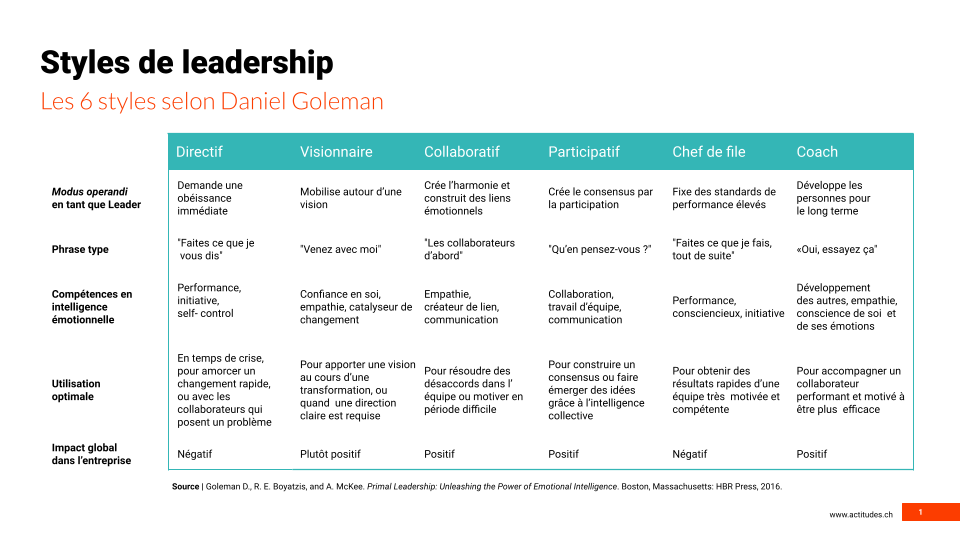How to use the 6 leadership styles
Daniel Goleman defines 6 leadership styles that are not mutually exclusive. As a leader, it's more a question of knowing how to navigate through these different managerial postures and "modulate" your leadership style to better adapt it to the needs of the context and your interlocutors:
- Direct Leader | Commanding
- Leader Chef de file | Pacesetting
- Visionary Leader
- Leader Collaborative | Affiliative
- Participative Leader | Democratic
- Leader " Coach " | Coaching
According to Daniel Goleman, it's crucial for leaders to hone their emotional and social intelligence, so they can "feel" the context and adapt their leadership style to match and "resonate" with their environment.
Any lack of coherence would be immediately detected by your teams, and would create a gap, a "dissonance" between the signal you wish to give as a leader and the message actually perceived by the team.
What is your preferred leadership style?
This comparison chart allows you to compare the advantages/disadvantages of different leadership styles, and gives you a better understanding of their effects on team dynamics.
Download Daniel Goleman's 6 leadership styles comparison chart:
THE 6 LEADERSHIP STYLES IN DETAIL
The "Direct" style
This is the most authoritarian style: it leaves little room for initiative, expects immediate action, and imposes the actions to be taken without explaining the overall vision.
- Effects on team climate: this style almost always has a negative impact on team dynamics! More often than not, an overly directive style seriously undermines the intrinsic motivation of teams, who don't feel their leader's trust, and don't see the meaning of their work.
- Optimal use: this style can, however, be useful in very special cases. For example, in crisis situations, when immediate action is needed, or to "tighten the screws" on employees who don't follow instructions or passively wait to be given specific tasks.
- This style does not work well for more complex tasks requiring team initiative and creativity. This style should therefore be avoided overall, and used sparingly and in a targeted manner in the situations we have just described.
The "leader" style
A little less authoritarian than the "Directif", this leadership style is no less demanding. The "Chef de file" leader aims for excellence and sets high performance expectations. They lead by example, setting the pace and forcing teams to follow.
- Effects on team climate: this style has a rather negative effect overall. People who can't keep up with the leader risk becoming discouraged and demotivated, with the impression that they're not up to the job. This style does not encourage teams to develop their skills.
- Optimal use: fast results from a highly motivated and skilled team.
- Beware! Leaders" may lack patience with under-performers and take over tasks for themselves (the only guarantee of getting exactly what they want), resulting in extra work for the leader and a loss of motivation, self-esteem and self-confidence for the person concerned, who is "set up to fail".
The "Visionary" style
This style implies charismatic leadership, which appeals to us and enables us to unite and mobilize a team around an inspiring vision.
- Effects on team climate: this style has a very positive overall impact on the team. Visionary leadership gives meaning and energy, and guides action by mobilizing the team around an inspiring vision.
- Optimal use: to give hope, overcome resistance to change, guide teams in a complex environment and show the way, e.g. during major organizational transformations, reorganizations, a change in the company's strategic positioning, a merger...).
- This style is not suited to crisis management, where you need to act quickly and be more directive. You also need to be able to translate your vision into concrete, tangible action, to remain credible in the eyes of your team over the long term.
The "Collaborative" style
Collaborative" leadership seeks above all the cohesion and participation of all team members. This leadership style encourages interaction and positive team dynamics.
- Effects on team climate: this style has a very positive impact overall, reinforcing cohesion and providing support to teams.
- Optimal use: the "Collaborative" style helps to ease tensions (internal competition, interpersonal conflicts) and strengthen mutual support and collaboration in difficult times.
- Beware! this style may be too "soft" and not stimulating enough for high-performing employees who expect a model closer to the "Leader", and does not allow them to feel valued as individuals, because "Collaborative" leadership focuses above all on the collective.
The "Participative" style
Participative" leadership seeks consensus through democratic means, and has a stabilizing and pacifying effect on teams. It willingly solicits opinions with an open, dialogical, listening attitude.
- Effects on team climate: this style of leadership is inclusive, making room for ideas so that everyone feels heard and part of the team.
- Optimal use: this style stimulates collective intelligence, co-creation and innovation, and makes the most of everyone's ideas and opinions. It enables every team member to be actively involved in decision-making.
- Beware! on the other hand, it's not very effective when it comes to obtaining quick results, and unsuitable or even dangerous in times of crisis! high performers who may become impatient with having to wait for the community's opinion before moving forward.
The "Coach" style
It's a leadership style that focuses on the long-term development of team members. Coach leaders invest time in understanding the intrinsic motivations and goals of their team members, and support them in their development while promoting their autonomy. This style is based on the notion ofempowerment.
- Effects on team climate: this style of leadership is positive, because each individual feels considered and supported in his or her development.
- Optimal use: this style helps people to improve themselves, develop their resources, be more efficient, more autonomous and also induces strong loyalty to the organization.
- Beware! This style is relatively difficult to implement, as it requires the ability to guide people while leaving them totally autonomous in their choices... To succeed in "supporting" without "prescribing", qualities of listening, empathy and benevolence are required, as well as confidence in each person's ability to improve. This style does not work with people who expect a more commanding management style.



